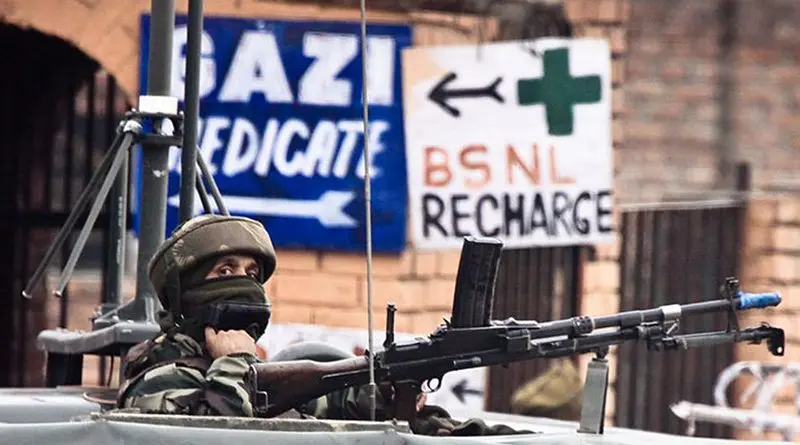J&K: Addressing Security Challenges Amid Political Uncertainty – Analysis
By IPCS
By Sarral Sharma
The ‘new’ phase of militancy in J&K that began after Burhan Wani’s killing in 2016 continues to present multiple security challenges. With an eye on upcoming elections, the security situation may further deteriorate if the Bharatiya Janata Party (BJP)-led government in New Delhi does not take appropriate counter-measures to address these challenges in the state.
New Dynamics
Despite the successes of Indian security forces in eliminating the top militant commanders of different outfits, especially after the launch of Operation ‘Al lOut’ in 2017, the recruitment drive and radicalisation continues unabated in the Kashmir Valley. Over 300 militants have been killed since the operation began in 2017. However, almost equal numbers have joined different militant ranks in the same amount of time. Although government data suggests that the approximate number of active militants in the Valley is between 250-300, the unofficial figures could be higher. Due to logistical constraints, however, such as unavailability of arms and ammunitions, only a limited number can finally be recruited into militant groups.
Local recruits cover a wide spectrum, varying from highly educated individuals, former security forces personnel to school and college drop-outs. An interesting and worrisome trend is that these recruits are not crossing over to Pakistan for arms training, or seeking ideological motivation. Instead, they are mostly self-motivated–some well-intentioned and some disillusioned–local boys volunteering to join militant ranks and to die for azadi (freedom).
This phenomenon is triggered by factors that include the continuing alienation and anger generated after the Valley-based Peoples Democratic Party (PDP) entered an alliance with rival BJP in 2015, in addition to mismanagement of other domestic affairs in Kashmir. Some Kashmiris also blame the security agencies’ ill-treatment of the local youth for the growing anger and increasing recruitment. Afzal Guru’s hanging in 2013 and widespread protests in 2008 and 2010 are other contributors to the current phase of militancy. Finally, the extensive use of social media platforms to share propaganda videos, letters,text messages and so on have further expanded militancy’s reach.
These factors have culminated in the form of street violence and militancy’s rising popularity in the past two and a half years. Further, local militants are receiving significant support from the civilian population. Mass funerals of militants, civilians thronging encounter sites in large number regardless of consequences, and incidents of stone pelting on security forces have increased since 2016.
Addressing Challenges
According to some reports, Hizbul Mujahideen (HM) remains the first preference for the new recruits, followed by LeT, and then JeM. New groups such as al Qaeda’s local branch, Ansar Ghazwatul-Hind (AGuH), Kashmir’s Islamic State (IS) affiliate, and the resurgent Al-Badr have propped up over the past two years. Notwithstanding their online presence, these groups have not been able to attract many recruits. However, their presence has created further complications for security agencies. The possibility of suicide or fidayeen-style attacks, targeted killings and Improvised Explosive Device (IED) blasts in the state cannot be ruled out in the current circumstances.
Incidents such as the snatching of weapons from security forces or randomly firing at security personnel have also increased; there has been a concomitant call for stringent Standard Operating Procedures (SOPs) to avoid similar occurrences in the future. As the first line of defence internally, the J&K police remain the most vulnerable target. Some unstated measures have been taken to strengthen the state police in order to avoid desertions, abductions andtargeted killings.
Anti-militancy operations across the Valley have been fortified under the Governor’s Rule. There appears to be better coordination between the central and state security agencies in this regard. Cordon and Search Operations (CASOs) and Search and Destroy Operations (SADOs) may further increase in vulnerable areas, such as the four districts of South Kashmir. Since 2016, security forces have somewhat adapted their SoPs to account for quick, precise and pre-dawn operations based on active intelligence inputs so as to avoid large gatherings at encounter sites, stone-pelting incidents, and possible civilian killings.
These measures must form elements of a long-term and creative strategy to deal with the current phase of militancy in the Valley. For instance, security agencies may consider creating splits within militant groups, or rivalries between the old and new outfits. Winning the confidence of the local population remains critical for overall success. For this, new operational tactics could be introduced to minimise civilian casualties during security operations such as finding a viable alternative option to pellet guns. The government must also look for ways to counter social media propaganda on Kashmir. Factual videos, tweets, blogs, photos, text messages can be shared systematically and with a planned strategy to counter false propaganda.
In view of the 2019 Lok Sabha elections, the central government will need to approach security challenges in J&K with innovation and clarity.
*Sarral Sharma, Senior Researcher, Centre for Internal and Regional Security (IReS)

